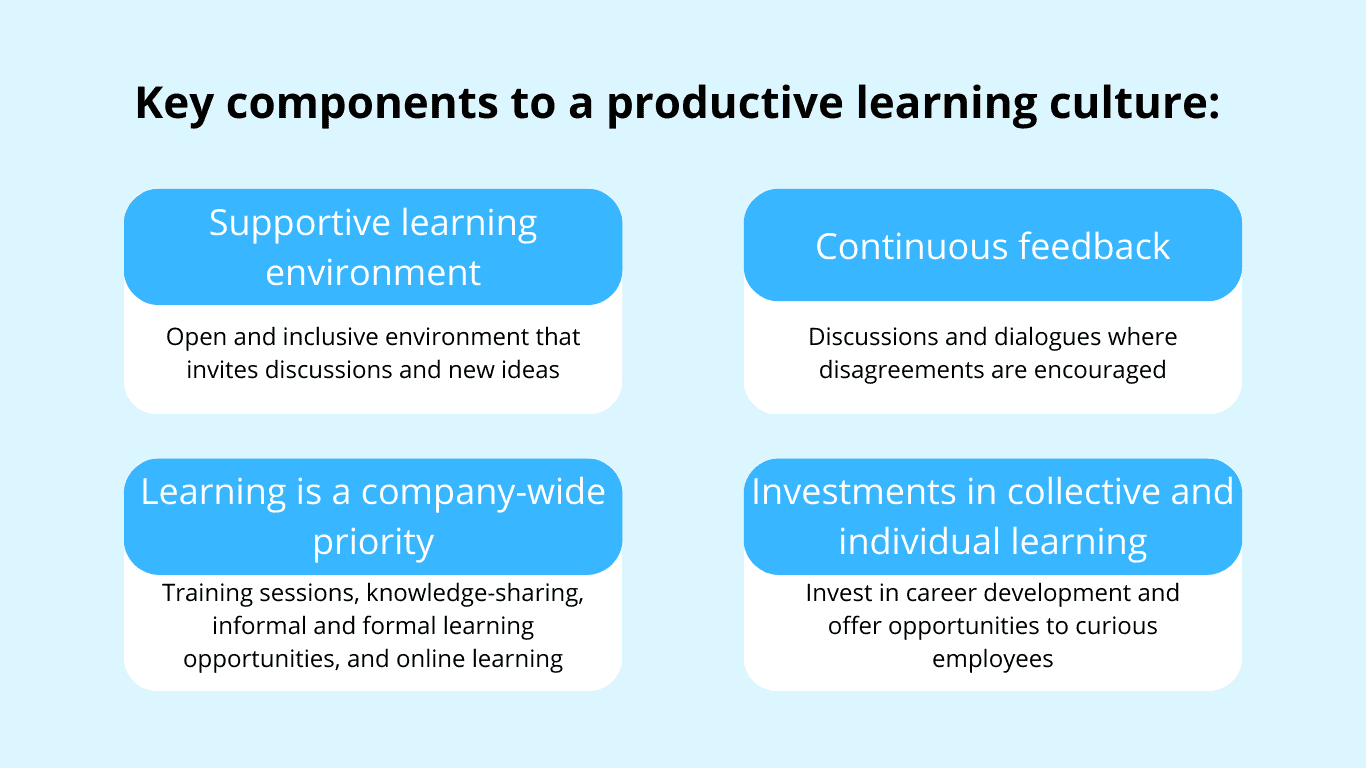A learning culture is the weapon you did not know you needed to combat uncertainty. A culture of learning makes your team more engaged, creative and resilient. This will make a huge impact on the company environment, employee wellbeing and business performance.

What is a learning culture?
A learning culture is an integral part of a company where the organisation emphasises the importance of understanding the values, practices, and skills sets that are integral to the company. If employees gain the knowledge and skills necessary to perform to the best of their ability, they will likely satisfy customers and help the overall business performance.
Creating a learning culture
Every member of your team should be aligned with those goals you as a business are hoping to achieve. This includes being aware of the values, products, customers and structure in the company. This is a crucial step towards achieving these goals – and a learning culture is a tool for ensuring that all employees are on the same page. The learning culture enables everyone to get the knowledge and skills they need to be aligned with the rest of the company.

Ensure that the workplace is perceived as an inclusive and open learning environment.
How to create a learning culture: 5 steps
1. Start with examining the current culture
Which learning strategy is in place and where are the learning gaps? If you examine and assess the strategy for how accessible it is for employees to learn, you can use the current situation to introduce steps that will improve the learning culture. This means tearing down how, what and how the employees are learning now.
While some learning will be informal and happen organically, other forms of learning should be structured. Make a plan for what you want the employees to learn and implement a strategy for how you can implement the plan. View this the same way you do an onboarding process, where you plan out which introductory courses or activities the new hire will go through. This same framework will make you better equipped to tackle a plan for an improved learning culture.
You might also be interested in: How to create a learning and development strategy?
2. Ask for input when creating the learning materials
You should consult learning experts and create content that enables your target audience to learn. Experts within the field should recommend content angles or even create the course material. The content must be structured in a thoughtful and impactful way, which only them with the necessary insight is able to do.
The learning materials must be targeted to the learner and give them the best possible starting point for gaining knowledge. An accessible pool of resources will benefit the learners (new employees) and those responsible for upskilling others as well (senior employees, HR, L&D, or external course instructors).
Remember! You should also ask your employees – the target audience – what they want to learn and how they learn best. It will be easier for you to improve the learning environment if you know how to cultivate for their needs.
3. Use accessible learning tools
The training should be accessible. This is the only way learning will be a priority for the employees. When the learning tools are accessible and the learning materials are engaging, the employees will set aside time to learn. Related to this, it should also be intuitive to use and available online. Online learning provides them with the flexibility to learn on the way to or from work.
You can offer them online courses through a learning management system (LMS). The LMS will be a tool for the employees to take courses on important subjects and improve their knowledge and skills sets in an area that is relevant and that they find interesting
Use the FrontCore learning tool
Many view a learning management system as the best solution to improve the learning experience. A good LMS has features that will keep participants engaged, like video training or progression insights. The FrontCore LMS allows participants to delve into a course that you have specifically designed for them down to the details.
4. Make learning fun and social
Social learning is a great way to promote activities that will close off the skills gaps that exist within the organisation. By making learning fun and social, you are more likely to engage your employees where they learn without knowing it. They share resources and take advantage of expertise that each person has. Informal learning like day-to-day discussions, group chats, or fun social games tied to scoreboards or competitive activities will promote learning.
5. Link learning to rewards and leadership
Ensure that all employees view learning and engagement as a way to better opportunities in the company, both collectively and individually. The way to accomplish this is to ensure that the concept of learning is ingrained in them from day one. If you onboard them in an effective way, either through LMS courses or mentoring, they will get used to learning from the get-go.
Additionally, you should promote learning as a way for them to develop and reach professional goals. Set aside them and encourage them to use learning tools in the work hours to brush up on skills or learn something new. People learn better if they are motivated and feel that they are putting in an effort to reach a specific goal.
6. Remember feedback sessions
Remember to give constructive feedback to employees you are learning new skills. They can use this feedback to improve further and reach certain goals faster. It should be possible for employees to provide feedback to you, which you should use as insight to adapt the learning tools. You should also adapt the offer based on results, both positive and negative results.
A key factor to feedback is also to remember to measure the success of your learning tools. Measure completion rates after courses, defined goals, or based on company-specific metrics, and ensure that everyone is tailoring the learning initiatives to the continuous monitoring of goals and feedback sessions.

Use accessible learning materials and customise the training sessions as you see fit.
Benefits of a healthy learning culture
A learning culture impacts all areas of the business. Most importantly it helps your employees feel successful and important in the company. It also helps your business grow and perform, which is why a continuous learning culture is an essential component of any successful business. According to research from CIPD, a healthy culture and work environment is crucial for employees’ ability to respond to challenges and adapt to changes in the workplace as well.
Learning culture matters in every aspect of the organisation:
- Increases engagement and retention: By investing in collective and individual learning and professional development, the employees feel that the organisation values them.
- Boosts creativity and innovation: Learning equals risk taking and growth opportunities. You learn while you fail, which is closely linked to creative forms of learning.
- Prepares everyone for disruption and change: If you are always prepared to learn and develop, you can act fast and adjust when you have no other choice. In a challenging financial period, you are more resilient and better equipped to find alternative solutions.
- Improves customer satisfaction: There is a ripple effect in employee engagement and creativity which benefits the performance and customer satisfaction. Engaged and passionate employees will produce a better product for their clients, which benefits the entire organisation.
Ensure that your company checks all the components of a learning culture
A continuous culture of learning
Continuous learning is a concept where the company is always «on» and prepared to motivate employees to learn new skills or gather new knowledge. Much like continuous learning, a learning culture should also be perceived as an effort that is always prioritised and improved.
As an employer, you need to make sure that all the components of a productive learning culture are being implemented and acted on at all times. You should work together with the HR and L&D department to give them the tools to roll out learning initiatives that are designed specifically for your employees and how they learn the best.
A stable and productive learning culture will ensure that the benefits of learning, like employee retention and customer satisfaction, are self-enforcing. This will always benefit the individual employee and the company as a whole.
Did you like this article? Don't forget to share it:






0 Comments